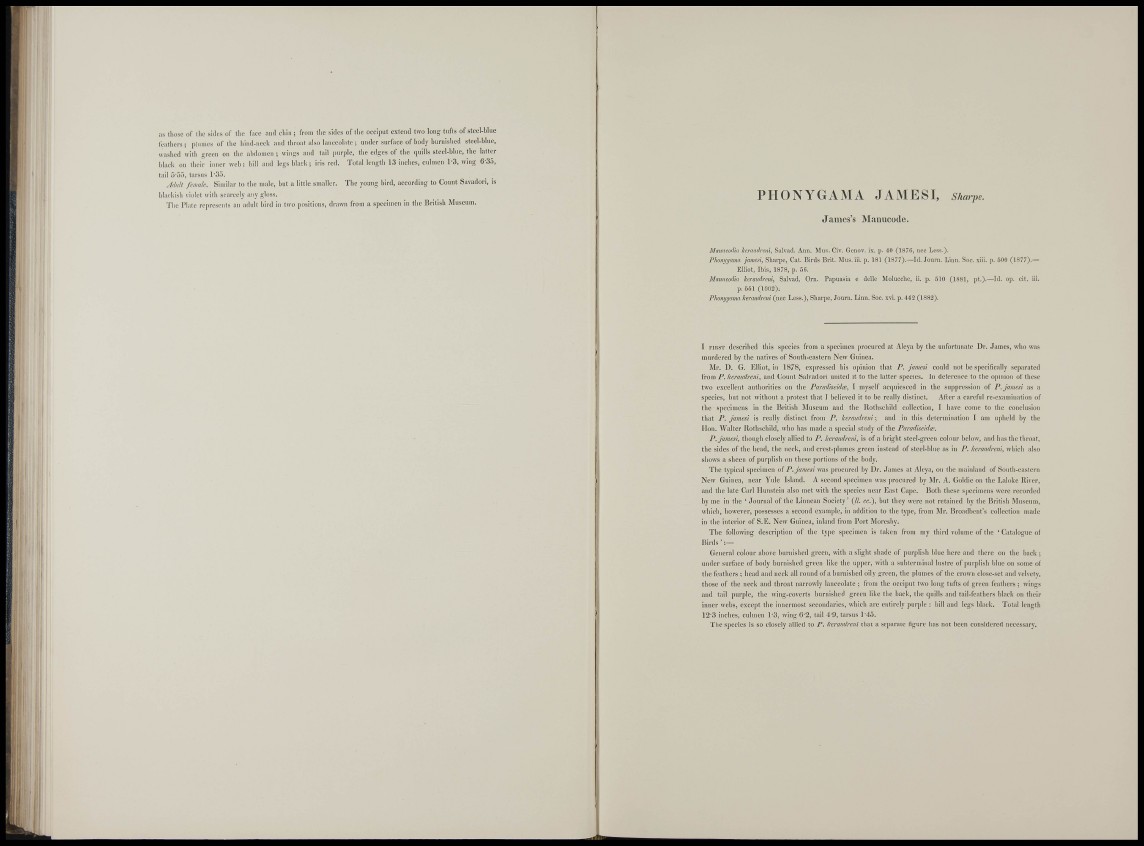
iis lliose oC the sides of tlie faco i\ml cliiii ; from the sides of tlie occii)iit extend two long tiifls of steel-blue
feiitlioi's; pinnies of the liiiid-iieck and tlirout also liiiieeolate ; under surface of body liurnislied steel-blue,
uaslied w itb green on the abdomen ; wings and tail |iur|)le, tbe edges of tlie quills steel-blue, the latter
black ou their inner web; bill and legs black; iris red. Total length 13 inches, culinen I'S, wing G'SS,
tail Jj'rir), tarsus I'^o.
AduU fmttk. Similar to the male, but a little smaller. Tbe young bird, according to Count Savadori, is
blackish violet with scarcely any gloss.
The Plate re|)resents an adult bird in two positions, drawn from a specimen in the British Museum.
PHONYGAMA JAMESI, sharpe.
James's Maiiucotle.
Manucodm hemudreni^ Salvad. Ann. Mus. Civ. Genov. ix. p. 40 (187(5, ncc Less.).
Pìmwjgama jamesi, Sharpe, Cat. Birds Brit. Mus. ili. p. 181 (1877).—Id. Journ. Linn. Soc. xiii. p. .500 (1877).—
EUiot, Ibis, 1878, p. 06.
Mamicodia ìterandreni, Salvad. Orn. Papuasia e delle Molueche, ii. p. 610 (1881, pt;.).—Id. op. eit. iii.
p. 551 (1882).
Phonygami heraudrmi (nec Less.), Sharpe, Journ. Linn. Soc. xvi. p. 442 (1882).
I FIRST described this species from a sjiecimen ¡iroeured at Aleya by the unfortunate Dr. James, who was
murdered by the natives of South-easteru New Guinea.
Mr. U. G. Elliot, in 1878, expressed his opinion that P. jamesi could not be specifically separated
from P. kemudreni, and Count Salvadori united it to tbe latter species. In deference to the opinion of these
two excellent authorities ou the Paradisetdce, I myself acquiesced in tbe suppression of P. jamesi as a
sjiecies, but not without a protest that I believed it to be really distinct. After a careful re-examination of
the specimens in the British Museum and tbe Rotlischild collection, I have come to the conclusion
that P. jamesi is really distinct from P. keraudreni and in this determination I am iq)hcld by the
Hon. Walter Rothschild, who has made a special study of the Paradiseidre,
P. jamesi, though closely allieil to P. keraudreni, is of a bright steel-green colour below, and has the throat,
the sides of the bead, the neck, and crest-plumes green instead of steel-blue as in P, keraudreni, which also
shows a sheen of purplish on these jjortions of the body.
The typical s])ecinien of P. jamesi was procured by Dr. James at Aleya, ou the mainland of South-easteru
New Guinea, near Yule Iskmd. A second specimen was procured by Mr. A. Goldie on the Laloke River,
and the late Carl Hunsteiu also met with the species near East Ca])e. Both these s|iecimens were recorded
by me iu the ' Journal of the Linneau Society' {II. ec.), but they were not retained by the British Museum,
which, however, possesses a second example, in addition to the type, from Mr. Broadbent's collection made
in the interior of S.E. New Guinea, inland from Port Moresby.
The following description of tlie type specimen is taken from my third volume of the ' Catalogue of
Birds ' : —
General colour above buruished green, with a slight shade of puriilish blue here and there on the back ;
under surface of body burnished green like tbe upper, with a subterminal lustre of j)urjilish blue on some of
the feathers ; head and neck all round of a burnished oily green, the jilumes of the crown close-set and velvety,
those of the neck and throat narrowly lanceolate ; from the occiput two long tufts of green featliers ; wings
and tail purple, the wing-coverts burnished green like the back, the qnills and tail-feather.s black on their
inner webs, except the iuiiermost secondaries, which are entirely purple : bill and legs black. Total length
12'3 inches, culmen 1-3, wing 0"2, tail 4'9, tarsus l-4o.
The species is so closely allied to P. keraudreni that a separate figure has not been considered necessary.